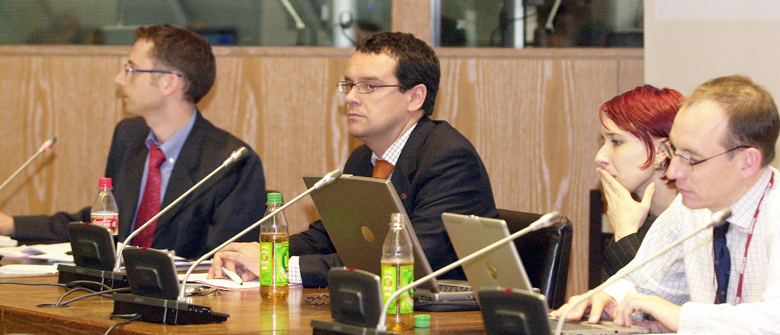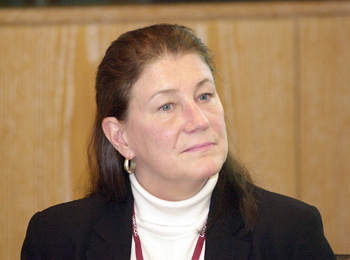 |
||
|
Published by the International Institute for Sustainable Development (IISD)
in cooperation with the UNFCCC Secretariat |
|||
|
Special Report on Selected Side Events at SB 24
|
|||||
| 15-26 May 2006 | Bonn, Germany | |||||
 |
|||
 |
|||
Events convened on Wednesday, 24 May 2006
|
The EU Emissions Trading Scheme: state of play Presented by the European Community |
|||||
|
Damien Meadows, European Commission (EC), outlined the “state of play” of the European Union Emissions Trading Scheme (EU ETS) following its first year in operation, described EC and Member States’ preparations for the second period, and discussed the future of the scheme post-2012. He emphasized that: the scheme has already influenced corporate behavior; increased transparency and simplicity are priorities for future periods; and stakeholders are particularly interested in long-term topics, including predictable allocation rules over longer time periods. He noted that a simple trading scheme is more likely to achieve its goals and provide a blueprint for other schemes. Sina Wartmann, Ecofys, provided an overview of the EU monitoring and reporting guidelines, noting that they were published in 2004 and aim to balance environmental integrity and cost effectiveness. She explained that the guidelines are based on a tiered approach, with different accuracy levels for calculating emissions, and that the highest tier should be used unless this is technically unfeasible or unreasonably costly. She informed that a revised version of the guidelines will be published in fall 2006 and that the revision focused on improving their cost effectiveness. Christopher Dodwell, Department for Environment, Food and Rural Affairs, UK, presented on the UK’s experiences with implementing the EU ETS. He noted the UK’s 99.6% compliance rate during the scheme’s first year and stated that the UK will set a target of 11-29 million tons of carbon dioxide below projected emissions for the 2008-2012 period. He identified UK priorities for the review of the Emissions Trading Directive, including: long-term certainty, increased simplicity and harmonization and inclusion of the aviation sector in the scheme. He stressed the need for robust and transparent assessments of national action plans to build confidence in the carbon market. Franzjosef Schafhausen, Federal Ministry for the Environment, Nature Protection and Nuclear Safety, Germany, said implementation of the EU ETS has led to a change in business culture, and that carbon dioxide is moving increasingly from the domain of environmental officers to that of chief executive officers. He outlined Germany’s climate change programme, highlighting targets on renewables, combined heat and power and energy efficiency. On the review of the EU ETS, he called for harmonization of emissions trading at the EU level, and sectoral differentiation. |
|||||
|
|||
|
Post-Kyoto negotiations: Africa priorities Presented by Kenya |
|||
|
Don Riaroh, Ministry of Energy, Kenya, emphasized that the effects of climate change, such as intense droughts and flooding, are already impacting Africa, noting these harm Africa’s infrastructure and economy as a whole. He underscored that countries responsible for the largest GHG emissions should consider equity, which is one of the key UNFCCC principles. He stated that this principle should not be lost in the implementation phase of the Convention and emphasized that Kenya supports the contraction and convergence of emissions.
Joshua Wairoto, Kenya Meteorological Department, noted that Africa proposed including a reference to equity during the 1997 Kyoto Protocol negotiations, which implied: a globally defined contraction budget by an agreed date that stabilizes concentration of GHGs in the atmosphere at a safe level; convergence to equal sharing of emission entitlements per person globally by an agreed date; and trading of entitlements. He identified equity as the way forward for Africa in the post-2012 regime. Noting the lack of CDM projects in Africa, he stated that the CDM could greatly benefit this continent. Aubrey Meyer, Global Commons Institute, presented contraction and convergence as a sustainable approach to resolving inequity issues. He discussed updated carbon dioxide emissions data and provided an overview of global energy needs, noting that unlimited growth in emissions is not viable. He described a number of carbon dioxide reduction scenarios, emphasizing that GHGs are being emitted faster than they are being reduced, and called for emissions allocations on a per-capita basis. Grace Akumu, Climate Network Africa, called on African delegates to involve African unions and regional economic commissions in the post-2012 negotiations, highlighting the transboundary nature of climate change impacts. She underscored the need to: consider the political and economic aspects of climate change; include equity in the post-2012 regime; and help create an impetus for CDM projects in Africa. Participants discussed the linkages in Africa between the UNFCCC and the Convention to Combat Desertification and whether the stabilization goal of 550ppm is too high. One participant said the small number of CDM projects in Africa is partly due to high transaction costs and noted the continent’s pressing energy needs for development. Another participant asked about activities in Kenya for promoting the CDM and the use of the Practitioner’s guide on project proposal development. |
|||
|
|||
|
Information on updates on the UNFCCC Roster of Experts Presented by the UNFCCC |
|||
|
James Grabert, UNFCCC Secretariat, explained that at SBSTA-11, Parties asked the Secretariat to develop a comprehensive roster of experts and update it periodically. He indicated that in 2000 the current roster was last updated and the initial Integrated Roster of Experts System (IROES) implemented. He stressed that the use of experts in various UNFCCC processes has grown overtime and is likely to increase further with the implementation of the Kyoto Protocol reviews. He stated that further developing the integrated approach would improve the current process used in supporting nomination of experts by Parties, as well as the collection and collation of nomination forms by the Secretariat and subsequent allocation of experts to review teams.
He explained that the IROES will centralize information on: lists of experts for Parties; experts’ contact details; and expertise, training and examination results. He underlined that developing an electronic nomination form to complement the current online facility would allow experts and Parties to update details in an efficient and timely manner. Jan Golinski, UNFCCC Secretariat, gave a demonstration of the prototype for the new IROES Web interface, noting that the national focal points would be provided with a username and password to access the pages. Grabert informed that the Secretariat plans to: continue to improve the updating process through COP-12; seek interest and support of Parties in undertaking IROES work; develop the electronic online nomination form; revise the roster of experts' web pages and system; and send notifications to Parties in late 2006 regarding the periodic update of the roster using a revised IROES. |
|||
|
|||
|
Energy policy and technology options: recent work from the IEA Presented by the International Energy Agency |
|||
|
Robert Dixon, International Energy Agency (IEA), presented the IEA report “Energy technology perspectives-scenarios and strategies to 2050”, which was drafted in response to a call from the Gleneagles G8 Summit for advice on cleaner energy futures and improving energy efficiency. He emphasized that the report focuses on the importance of energy technologies, including carbon capture and storage (CCS) and hydrogen fuel cells, for sustainable development and on barriers to their deployment. He suggested the report’s analytical framework creates a global multiregional model on energy technologies, based on World Energy Outlook and Accelerated Technology Scenarios. He highlighted that the most important technologies for the future include CCS, renewables, and hydrogen fuel cells, and those that lead to efficient use of natural gas and energy efficiency.
Debra Justus, IEA, highlighted that CCS is a necessary technology for a low carbon future. She outlined the status of CCS development, further research needs, CCS prospects and legal aspects. She stressed the need for public acceptance of CCS and suggested it could play an important role in the power sector. She called on countries to create a long-term policy framework for deploying CCS. Nicholas Lefevre, IEA, highlighted a study on ways to advance the deployment of climate-friendly technologies in developing countries. He suggested that technology deployment will play a key role in climate change mitigation and that an approach encompassing a range of technologies is better than focus on a “silver bullet.” He noted that efforts to deploy such technologies are greater in OECD countries than in developing countries, and stated that UNFCCC mechanisms, such as the CDM, do little to reverse that trend. He presented a case study of solar photovoltaics deployment in China and India as a way to expand the geographical focus of OECD investments in new technologies. Alan Meier, IEA, examined the implications of fuel-efficient tire use on energy consumption and emission reductions. He emphasized the lack of publicly available data on the design of such tires and noted some IEA efforts to harmonize the testing procedures for estimating their energy efficiency. Participants discussed: the applicability of global technology scenarios to national circumstances; costs of CCS; consideration of energy scarcity in technology scenarios; regional variations in costs of solar cell deployment; criteria for measuring technology transfer; and the extent of energy savings from fuel-efficient tires. |
|||
|
|||
|
Mitigation and adaptation to climate Presented by the International Federation of Organic Agriculture Movements |
|||
|
Louise Luttikholt, International Federation of Organic Agriculture Movements (IFOAM), explained that the mission of IFOAM is to promote organic agriculture world-wide. She noted that organic agriculture is a holistic system that uses natural inputs and that its principles focus on health, ecology, fairness and care. She highlighted that organic agriculture is practiced on 31 million hectares in 120 countries. She noted the potential of organic agriculture to sequester carbon and contribute to adaptation to climate change. She stressed the need to make organic agriculture an explicit land use in national inventories.
Ferko Bodnár, Agro Eco, highlighted a pilot project on climate-neutral peanuts in Matai, Tanzania, saying it is an example of how organic agriculture could help combat climate change. He outlined the project’s goals, including mobilizing funds for climate change mitigation, developing a monitoring system, and building a carbon payment system for organic farmers. He noted that despite the fact that the project sequesters carbon, builds soil organic matter, and increases water-holding capacity, it is not eligible under the CDM. He highlighted the project’s next steps, including fundraising for implementation. Participants discussed what incentive exists for farmers to participate in the climate neutral project, and the poor soil nutrient conditions of degraded land as an impediment to organic agriculture. |
|||
|
|
|||
|
||
|
Click the above button to go back to our ENB main coverage
|
||
|
|
|
|
|
||
|




















